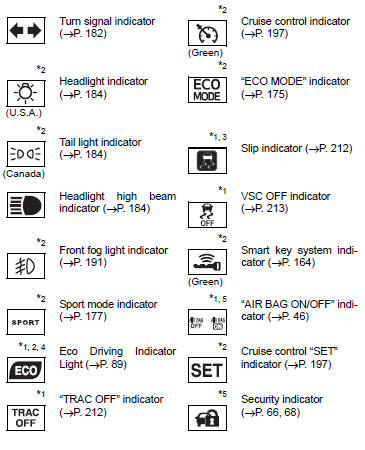Toyota Corolla (E170): Indicators
The indicators inform the driver of the operating state of the vehicle’s various systems.

*1: Vehicles without a smart key system: These lights turn on when the engine switch is turned to the “ON” position to indicate that a system check is being performed. They will turn off after the engine is started, or after a few seconds. There may be a malfunction in a system if a light does not come on, or if the lights do not turn off. Have the vehicle inspected by your Toyota dealer.
Vehicles with a smart key system: These lights turn on when the engine switch is turned to IGNITION ON mode to indicate that a system check is being performed. They will turn off after the engine is started, or after a few seconds. There may be a malfunction in a system if a light does not come on, or if the lights do not turn off. Have the vehicle inspected by your Toyota dealer.
*2: If equipped
*3: The light flashes to indicate that the system is operating.
*4: The light does not turn on when the system is disabled.
*5: This light illuminates on the center panel.
CAUTION
■If a safety system warning light does not come on
Should a safety system light such as the ABS and SRS warning lights not come on when you start the engine, this could mean that these systems are not available to help protect you in an accident, which could result in death or serious injury. Have the vehicle inspected by your Toyota dealer immediately if this occurs.
Other materials:
Circuit description
Refer to dtc p0010
Dtc no.
Dtc detection condition
Trouble area
P0011
Condition (a) or (b) continues after engine is warmed up and
engine speed at 550 to 4,000 rpm (problem of the advanced
ocv):
valve timing does not change from current valve tim ...
Driving tips
Winter driving tips
Carry out the necessary preparations and inspections before driving the vehicle
in winter. Always drive the vehicle in a manner appropriate to the prevailing weather
conditions.
Preparation for winter
● Use fluids that are appropriate to the prevailing outside temper ...
Precaution
1. Work precautions
(A) vehicle protection
(1) when welding, cover glass, seats, carpets, etc. With
heat resistant fireploof covers to protect them.
(B) safety
(1) never stand in the path of the chain when using a puller
on the body or frame, and be sure to attach a safety
cable.
...


